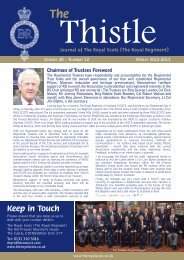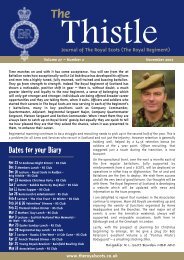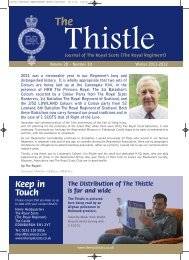Download Now - The Royal Scots
Download Now - The Royal Scots
Download Now - The Royal Scots
You also want an ePaper? Increase the reach of your titles
YUMPU automatically turns print PDFs into web optimized ePapers that Google loves.
Laying-up Colours<br />
As many of you will know, before the<br />
Japanese attack on Hong Kong in 1941, the<br />
2nd Battalion sent their Colours and other<br />
property to Singapore for safekeeping.<br />
Of course, Singapore was itself overrun<br />
and the Colours lost; although the<br />
Regimental Colour was recovered after<br />
the war. (<strong>The</strong> story appears on page 275<br />
of Volume 2 of “Pontius Pilate’s<br />
Bodyguard”.) In 1948 HRH <strong>The</strong> Princess<br />
<strong>Royal</strong> presented new Colours to the 2nd<br />
Battalion in Dreghorn Barracks but in the<br />
following year the amalgamation of our<br />
two battalions took place. However the<br />
2nd Battalion Colours remained with the<br />
1st Battalion and were never laid up. As a<br />
result of the demise of the Regiment, it<br />
was decided that we should correct this<br />
anomaly and, at a short ceremony on 5<br />
October 2007, the Colours were placed in<br />
a display case in the members’ entrance<br />
hall at <strong>The</strong> <strong>Royal</strong> <strong>Scots</strong> Club.<br />
page 10<br />
<strong>The</strong> Child of Waterloo<br />
This is an edited version of an account that appeared in <strong>The</strong> Thistle of June 1895 written by an old soldier calling himself<br />
“An Old Milestone”. <strong>The</strong> Milestones was a nickname given to the Regiment because the ‘1’ worn on accoutrements looked<br />
like an old fashioned milestone.<br />
“At the time I write of it was customary for soldiers’ wives to follow and accompany their husbands’ regiments on<br />
active service many of them being present at every engagement in the Peninsula from Corunna to Waterloo.<br />
<strong>The</strong> subject of this sketch, Sergeant Donald Crawford, was rescued on the field of Waterloo when nestling as a child<br />
in the bosom of his mother, who was killed in action. It may be asked what was she doing there, but the poor<br />
woman knew of nowhere else to go, and naturally followed the Regiment, in whose ranks her husband fought and<br />
fell on the same day as herself. Fortunately for wee Donald he was seen by a Private who was fighting in the ranks,<br />
who “fell out” for a moment and picked him up, laying him lengthways across his back on the top of his knapsack<br />
lodging him between his rolled greatcoat and the nape of his neck, and immediately resumed his place in the front<br />
rank of the fighting line, where the little fellow was happy as a sand boy. I regret, at this distance of time, I cannot<br />
recall the good man’s name, which is worthy of record, though I have heard it in connection with Sergeant<br />
Crawford, with whom I served in the 1st Battalion, who revered the man’s memory with all the affection of a son for<br />
a father.<br />
In the year 1818, the 3rd and 4th Battalions, notwithstanding their distinguished services, were disbanded, the<br />
supernumerary officers being placed on half pay, and such NCOs and men who did not elect to be discharged were<br />
drafted into the 1st and 2nd Battalions. <strong>The</strong> 1st was stationed in the West Indies, and the 2nd in the East. <strong>The</strong> latter<br />
embarked at Gibraltar in 1807 and did not return to Europe until 1832, when they were quartered in Edinburgh<br />
Castle. According to the tradition of the Regiment, there was only one man left in the Battalion, a Private in the<br />
ranks, who embarked with it at Gibraltar and who returned after its twenty-five year’s abroad.<br />
<strong>The</strong> good fellow, who so humanely, in the heat of battle, picked up the child Donald Crawford, elected to join the<br />
1st Battalion, to which he brought the boy with him, sharing with him his rations until he grew old enough to be<br />
enlisted, by special authority, as an acting drummer at ten years of age. <strong>The</strong> boy was clothed by the Regiment,<br />
and his guardian made him attend the Regimental School from his early childhood, through which he received a<br />
useful education, and grew up to be a smart able-bodied soldier. Being ambitious to get on, he left the Drums and<br />
joined the ranks, when he was appointed Lance Corporal, and in due course attained the rank of Sergeant.<br />
<strong>The</strong> incident of his having been picked up on the field of Waterloo, and going through the engagement in the<br />
manner described, having been brought to the notice of the Duke of Wellington, he ordered him to be granted the<br />
Waterloo medal, to which his father would have been entitled had he survived the action, as he was under fire<br />
during the whole three day’s engagement. He wore the medal on his left breast, until he was discharged to pension<br />
in the year 1851, at Halifax, Nova Scotia, where he elected to settle, like many other time-expired men of the<br />
Regiment, most of whom did well in colonial life.”










